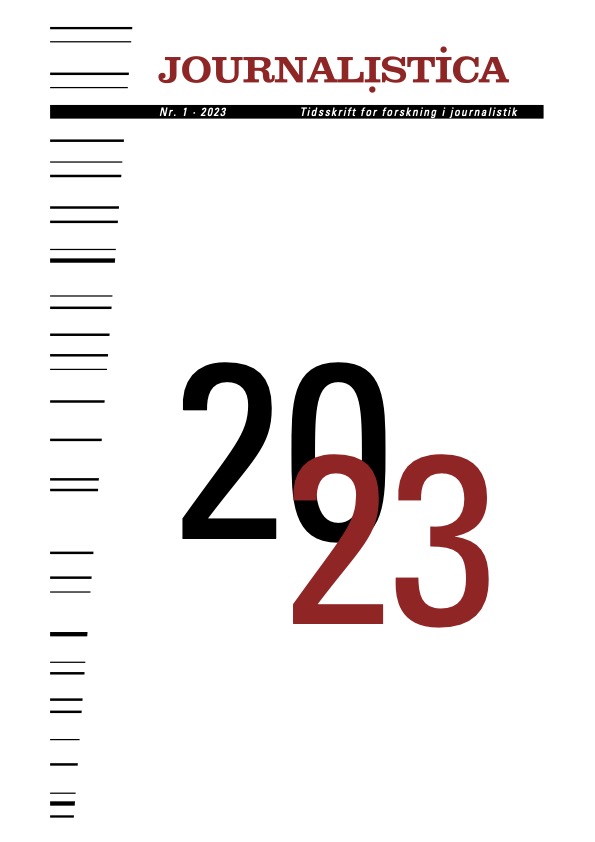Psychophysiological methods
DOI:
https://doi.org/10.7146/journalistica.v17i1.137235Keywords:
psychophysiology, cognition, emotion, eye tracking, electrodermal activity, media effects, journalism receptionAbstract
In this section, Journalistica puts a spotlight on research methods used in journalism studies and/or journalism practice.
Listen to the Journalistica podcast episode about this article on Spotify or in your browser.
References
de Haan, Y. Kruikemeier, S., Lecheler, S., Smit, G. & van der Nat, R. (2018). When Does an Infographic Say More Than a Thousand Words?, Journalism Studies, 19(9), 1293-1312, https://doi.org/10.1080/1461670X.2016.1267592
Gidlöf, K., Holmberg, N., & Sandberg, H. (2012). The use of eye-tracking and retrospective interviews to study teenagers’ exposure to online advertising. Visual Communication, 11(3), 329-345. https://doi.org/10.1177/1470357212446412
Grabe, M. E., Lang, A., & Zhao, X. (2003). News Content and Form. Implications for Memory and Audience Evaluations. Communication Research, 30, 387-413. http://dx.doi.org/10.1177/0093650203253368
Hassler, J., Maurer, M., & Oschatz, C. (2019). What You See Is What You Know: The Influence of Involvement and Eye Movement on Online Users' Knowledge Acquisition. International Journal of Communication, 13, 3739-3763. https://ijoc.org/index.php/ijoc/article/view/10937
Heiselberg, L. (2021) Methodological Innovation in Industry-based Journalism Research: Opportunities and Pitfalls using Psychophysiological Measures, Journalism Studies, 22(11), 1504-1524, https://doi.org/10.1080/1461670X.2021.1919545
Holmberg, N. (2016). Effects of online advertising on children's visual attention and task performance during free and goal-directed internet use: A media psychology approach to children's website interaction and advert distraction. [Doctoral Thesis]. Lund University. https://doi.org/10.13140/RG.2.2.34031.64168
Holsanova, J., Holmberg, N., & Holmqvist, K. (2009). Reading information graphics: The role of spatial contiguity and dual attentional guidance. Appl. Cognit. Psychol., 23(9), 1215-1226. https://doi.org/10.1002/acp.1525
Kruikemeier, S., Lecheler, S., & Boyer, M. (2018). Learning From News on Different Media Platforms: An Eye-Tracking Experiment, Political Communication, 35(1), 75-96, https://doi.org/10.1080/10584609.2017.1388310
Lindholm, J., Backholm, K. & Högväg, J. (2018). What eye movements and facial expressions tell us about user-friendliness. Testing a tool for communicators and journalists, in Hornmoen, H., & Backholm, K. (Eds.), Social Media Use in Crisis and Risk Communication: Emergencies, Rumours and Lifesavers. Emerald. pp. 205-225. https://doi.org/10.1108/978-1-78756-269-120181014
Moore, R. A. (2007). Ethical Considerations for Psychophysiology Studies. Research Ethics, 3(2), 40–45. https://doi.org/10.1177/174701610700300203
Potter, R. F., & Bolls, P. D. (2012). Psychophysiological measurement and meaning: Cognitive and emotional processing of media. Routledge/Taylor & Francis Group. https://doi.org/10.4324/9780203181027
Simola, J. M. (2011). Investigating online reading with eye tracking and Eeg: The influence of text format, reading task and parafoveal stimuli on reading processes [Doctoral dissertation]. University of Helsinki. http://urn.fi/URN:ISBN:978-952-10-7358-8
Soroka, S., Gidengil, E., Fournier, P., & Nir, L. (2016). Do Women and Men Respond Differently to Negative News? Politics & Gender, 12(2), 344-368. https://doi.org/10.1017/S1743923X16000131
Downloads
Published
How to Cite
Issue
Section
License
Copyright (c) 2023 Nils Holmberg, Lene Heiselberg, Jenny Lindholm, Erik Knudsen

This work is licensed under a Creative Commons Attribution 4.0 International License.
Forfattere, der publicerer deres værker via dette tidsskrift, accepterer følgende vilkår:
- Forfattere bevarer deres ophavsret og giver tidsskriftet ret til første publicering, samtidigt med at værket er omfattet af en Creative Commons Attribution-licens, der giver andre ret til at dele værket med en anerkendelse af værkets forfatter og første publicering i nærværende tidsskrift.
- Forfattere kan indgå flere separate kontraktlige aftaler om ikke-eksklusiv distribution af tidsskriftets publicerede version af værket (f.eks. sende det til et institutionslager eller udgive det i en bog), med en anerkendelse af værkets første publicering i nærværende tidsskrift.
- Forfattere har ret til og opfordres til at publicere deres værker online (f.eks. i institutionslagre eller på deres websted) forud for og under manuskriptprocessen, da dette kan føre til produktive udvekslinger, samt tidligere og større citater fra publicerede værker (se The Effect of Open Access).




